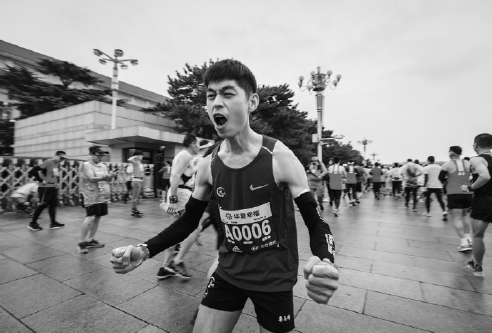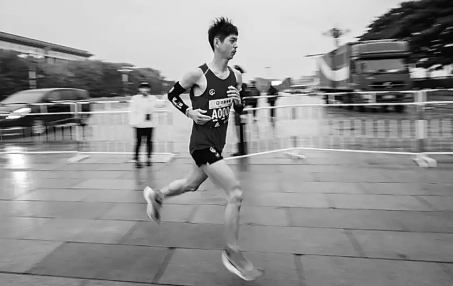The refreshment stop nobody wants
The coronavirus has left many of us itching for normality, and perhaps those who love long-distance running are among those who feel that pain most acutely, Zhang Lei reports.

There's a distinct chill in the spring morning air, but it's going to take more than a bit of physical discomfort to keep Luan Yushuai from doing what he has to do. Despite his heavy workload as a parcels deliveryman in the Haidian district of Beijing, he's determined to squeeze in time for a short run in Xitucheng Park. It's almost as though Luan feels his life and happiness depend on his getting out into that park. In fact, when you consider how integral running has become to him over the past three years, perhaps they are.
So pity someone like Luan, largely bound to his home-work aside-over the past few months because of mass gatherings being banned throughout the country as a result of the COVID-19 epidemic.
But of course that was not going to deter Luan. He simply continued his workout routine within the confines of his home, but now that things are slowly returning to normal in Beijing, he has resumed his morning outdoor runs, wearing a mask and having Xitucheng Park almost to himself as he runs.
Until three years ago the only activity that required Luan to get his legs moving and for him to put on a burst of speed was when he occasionally had to make an urgent delivery. For him, running was strictly a spectator sport, something he watched others doing as he made his deliveries in the Jiaotong University area. Eventually though, Luan decided that he too should get in on the running act, and like many of those he saw who were serious, no-half-measures athletes, he decided that he would set an imposing challenge for himself: to run a marathon.
After several months of slowly building up his muscles, his stamina and the distances he was running, he entered the Beijing Marathon in 2017. His employer, JD Logistics, was a sponsor of the event and offered places in the race to any of its employees deemed to have a chance of acquitting themselves well in the event. Luan took up the challenge, and when he finished in a highly respectable time of 4:23:43 workmates quickly surrounded him, offering their congratulations.
"Of course, at the finish I was absolutely exhausted, but I felt as though in completing the event all my bones and muscles had got this terrific boost," he says.
With that success and the recognition and encouragement that ensued, running became a focal point of his life, and he threw himself into studying physiology and about various techniques used in long-distance running. Under the tutelage of more seasoned runners he kept up a rigorous training routine, most of that being out on the road or in the park, where he was frequently clocking up 300 kilometers a month so as to increase his performance in future races.
Whenever his heavy workload gave him no time to go out for a run, he tied sandbags to his legs so that by the end of the day he would feel that he had at least got in some good power training.
All the hard work paid off, because in the 2018 Beijing Marathon, a year after his first, he completed again and shaved off more than 90 minutes from his earlier time, finishing in 2:53:05.
Last year, keen to improve his performance even more, he joined Yuandadu Marathon Club, founded in 2016, that provides a scientific system of marathon training for runners. The club has more than 600 registered members, more than 120 of whom can boast of having completed a marathon in under three hours.
Shedding more sweat and armed with the scientific training the club gave Luan, in last year's Beijing Marathon he shaved about 22 minutes off his record, finishing in 2:31:44.
As zippy as Luan may be when he dons a pair of running shoes, his arrival at the marathon party came rather late, for jogging and long-distance running have been all the rage in China for at least five years. That enthusiasm has sprouted running teams and clubs around the country that range from those who hit the streets as a mainly leisurely pursuit to those who are professionals who take part in as many big events as they can, in China and even overseas.
Within hours after registration opened for last year's Beijing Marathon the event had attracted 110,000 entries, which means gaining a start in the race is not unlike that other great Beijing lottery, the ballot for a car registration license.
In fact, since 2016 marathons have sprung up like cherry blossoms around the country, the three most well-known spring races being those in Wuxi and Xuzhou in Jiangsu province and Wuhan in Hubei.
But dainty cherry blossoms are probably the last thing on the minds of those who undergo training at the Yuandadu Marathon Club that, says Wu Ping, a spokeswoman, is endowed with paramilitary rigor that includes efficiency and practicality.
"The year's program is split into winter training, summer training and competition season training, so as to ensure continuity and that everything is arranged systematically over the year.
"The training plan is centered on Wednesday's intensity class and Sunday's long-distance class, and a weekday secondary class focuses on recovery adjustment and quality cross-training."
During the competition season training, the training level is switched to competitive mode, as an impetus to improving runners' performance. The runners are put into six groups based on their fitness and running abilities, each group having a captain, a deputy captain and an instructor.
Wu says this inverted pyramid management model is efficient in setting up a group evaluation system that brings runners with similar capabilities together to maximize the training benefits.
"Long-distance running is more than physical exercise," says Shan Wenlu, a club member whose best marathon time is 03:14:58.
"It's all to do with improving the way you think, and can even be considered spiritual. In a marathon you'll get some people who run at a very fast clip and another group that's a lot slower. What I really love is that as you train with a group in the club, looking out for one another and communicating with one another, everyone performs to the peak of their individual capabilities."
For any runner, be it a novice or a seasoned athlete, being aware of one's body is paramount, she says.
Absolute novices are advised to begin by jogging just a few kilometers and gradually building the distance up over days and weeks and settle down to running at a speed of 6-7 minutes a kilometer, eventually running five to 10 kilometers a day.
"When you start running, your bones, muscles and ligaments will be relatively weak, so it's easy to injure yourself if you push things too much. Usually, you should begin high-intensity running and endurance running after a year or two of training."
By 2018, 285 prefecture-level cities in China's 31 provinces, autonomous regions and municipalities, or 85 percent of all cities, had hosted marathons.
As the number of events continues to rise, so does their quality, and last month the International Amateur Athletics Federation bestowed on the Shanghai Marathon the title of Platinum Label, the first marathon in China so honored.
Until recently the Chinese marathon calendar had 13 gold-standard events that tended to hog the limelight. However, the huge number of entrants for other events, as well as the number of spectators, good event organization and new technology have engendered a whole new industry and marketing chain that includes gyms, running apparel, fitness monitors such as watches and apps, vitamin supplements and travel.
In fact, the biggest hurdle in the way of this growing industry at the moment comes in the shape of a virus called COVID-19. As with other sporting events, many marathons were put on hold recently, but many runners held great hopes that with the epidemic all but vanquished, they could resume training for their next marathon soon. However, those hopes were dashed on April 6 when the China Athletics Association drew attention to a decree the State Sports General Administration had issued six days earlier headed "Notice relating to non-resumption of marathon and other sports events".
"We're still optimistic, hoping we can get back to normal after summer," says Wu, the Yuandadu Marathon Clubs spokeswoman.
"Even if we get back to normal by the end of the year, we'll keep our spirits up and keep personal fitness for the coming year."
The shutdown will have fueled rather than dampened runners' enthusiasm for competition, a sentiment that can only grow stronger over coming weeks and months, she says.
This year's Wuhan Marathon was to have taken place on April 12, which turned out to be four days after the city's lockdown was lifted. Though the race was canceled, organizers staged an online charity event called Run with Wuhan that attracted more than 390,000 registrations.
For this online event, runners were required to complete a solo run of at least 4.12 km on April 12, recording their performance using any running app. Nearly 70,000 runners across the country took part and compared notes about their performances as well as giving encouragement and congratulations.
Just as the Wuhan online event gave runners plenty of time to reflect on their performances, the epidemic lockdown has given those in the long-distance running industry the chance to think about the direction in which it is headed.
Bao Mingxiao, director of the China Sports Economic Research Center, believes that, as in many other fields, the COVID-19 epidemic has been highly disruptive, but that it has also exposed and magnified some of the sport's deficiencies.
"We should not be content merely to take short-term measures as we react to our present situation, but also make changes to deal with longstanding problems in institutional mechanisms, ensure that we have the ability to deal with unforeseen threats and continue to grow."






































